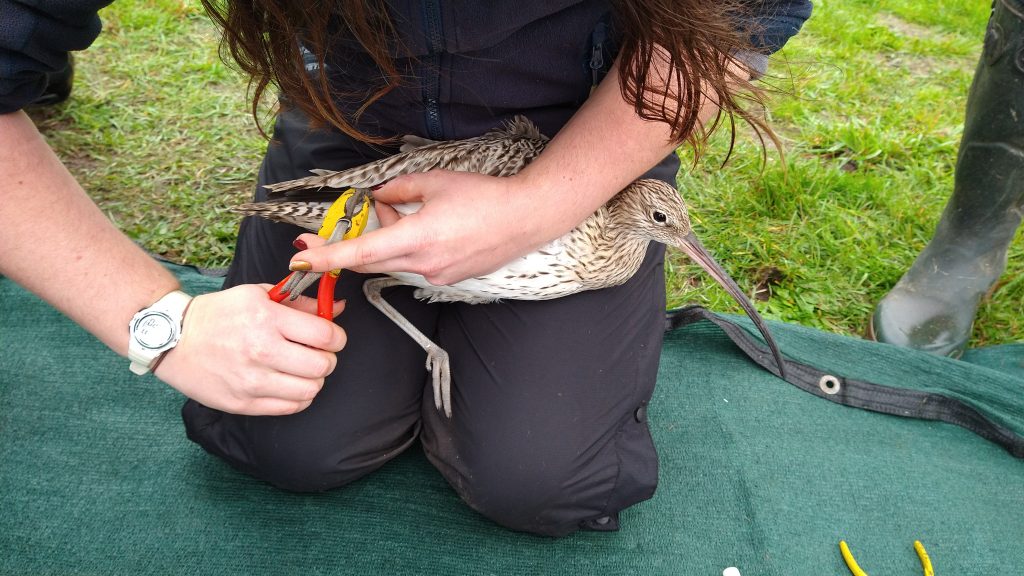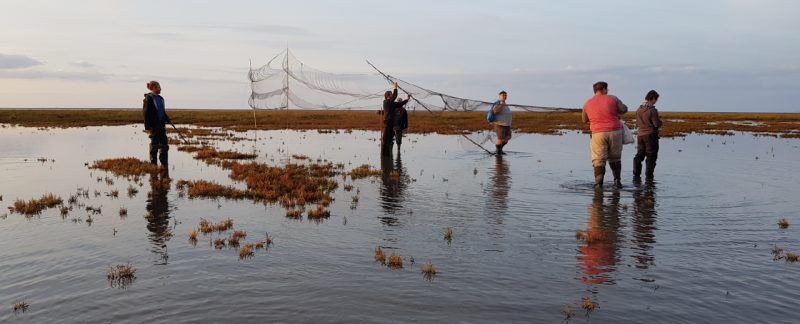The following trip report was written by Sebastian Cooksey, age 14
BOOM! The cannons fired and the best weekend of my life had just started. After lying for around an hour in the grass, we suddenly rushed to our feet and were running to the catch. From first glance, we realised it was a wet catch, nonetheless we waded into the water and started the process of ushering the birds up onto the drier beach. Water flooded into my wellies, but the excitement overpowered the discomfort. When the birds were all up on the beach, nicely rolled into a pocket, we could calm down. I could appreciate what we had caught, lots of pearl-white Sanderlings mixed in with a few Ringed Plovers. We could now start the extracting process and I was going to just stand and watch the experienced ringers have the fun, but Rob encouraged me to go do some extracting and before long I had three Sanderlings in my hand ready to put in keeping boxes. I was really grateful that Rob encouraged me to get involved and I feel like all the other people I met on this trip were all just as welcoming and trusting. This is what made me enjoy this weekend so much.
When all the birds were in their keeping cages we could start the ringing and processing. So we split into two teams and I joined the ringing team. I got a Sanderling out of the cage and proceeded to ring it. I have never ringed a Sanderling before and as a matter of fact I have never ringed a wader before. Prior to this experience I had never gone above the third hole of the pliers. The rings on the Sanderlings were hard, but Guy, the leader of the ringing team, was patient and helped me whenever I asked to ensure the bird’s safety. Whilst we were ringing the Sanderlings, the Autumnwatch crew were filming sections on Sanderlings and we were in the background, which was cool. After the Sanderlings, we each got to ring a Ringed Plover; this was an odd experience as the ring had to go above the knee as they are prone to damaging the rings in the rocks. The processing and ringing took over three hours, mostly due to the film crew, but it was an amazing experience and we ended up ringing 45 Sanderling and five Ringed Plover.
After the busy morning, we didn’t have much downtime and after a quick lunch we went out to set the Curlew nets for the proceeding cannon netting session. The ‘grotting’ of the nets took the most time as it involved laboriously picking up dead grass from the ploughed field. After the nets were set up we went out and set up some more nets, but this time mist nets and in the marsh nearer base. We then went back and had dinner at the base before heading out at dusk to check the nets. For me, this was a novel experience as mist netting near me is usually in the day and we extract birds in the light, but here that was not the case. On arriving, the extremely loud lures were put up, which could be heard from the sea wall as it was calm. When it was dark enough, we all went out with our bags and sacks on an extracting mission. We followed the untrustworthy glow sticks over the treacherous marsh, but I wasn’t looking at the ground, the stars above were mesmerising and glinting like a thousand diamonds. When we reached the nets, the lures were deafening and birds were flying around everywhere. After extracting and regrouping we prepared ourselves for the walk back. A group of people were carrying birds back and the others were taking down the nets. Bird-laden, we made our slow careful walk back.
Back at the cow barn, we sorted the birds into separate cages and decided on the ringing and processing teams. The ringing went on for a few hours and it wasn’t until midnight that we finished. Over the session we did loads of new species for me and I was allowed to do all of them and I enjoyed every minute of it. In the session we caught: Dunlins, Knot, Turnstone, Redshank, Greenshank, Black-tailed and Bar-tailed Godwits and the total number ended up being 123. Periodically the cows came to observe and obtrusively stuck their heads through the bars to get a closer look. After all the fun we decided to get some sleep for the excitement of the next day.
Sunday morning was a lie-in and we got up at a respectable hour (5:30 am!) before heading to the site where we had set the cannon nets previously. We then got there and had a sudden excitement where we all rushed to the bank, but it turned out to be a false alarm so we went to our cars where we sat out the rain. Then out of nowhere a single word was uttered on the radios: ‘GO!’ It was all action after that – we had to run over 200 metres to where the nets had fired before extracting the 12 Curlews that we had been lucky enough to catch. We then brought back the very heavy sacks and started the complex bird processing stations. The birds had rings put on them, then were colour ringed and processed before finally having GPS tags added to the collection and then they were monitored and released. The ringing took a few hours and we had a few curious onlookers as the day went on. I got the amazing experience of ringing one of the Curlews, which was the biggest bird I had ever held and it was difficult adjusting to the way of holding it. The morning was successful as 10 Curlews had been tagged and released. We then went back to the base to have ‘breakfast’ at 1 o’clock.

Then we got our only hours of downtime which I used to catch up on homework due the next day and many of the others for sleep and rest. We drove to Wolferton at 7 pm and got ready for the next mist-netting session. Next, a quick dinner of delicious soup and stories of the deep marsh we were about to endure. We did the usual prep and headed out onto the marsh. 30 minutes later, and with lots of teamwork we made it to the where the nets had been put up and found comfy spots on the marsh to wait. Every 15 minutes we would take turns to go and check the nets and extract if necessary. The number of birds we caught wasn’t as great as the previous night, but a few new species nonetheless. We brought back the birds to the cars and lights on the other side of the sea wall. The new species were: Oystercatcher, Grey Plover and a rather unexpected Black-headed Gull. The ringing was swift this time as we had lots of cute, bubbly Dunlins to do and I got used to their fluffy little bodies. After the birds were finished we said goodbye and started the long drive home.
I really enjoyed this trip and as I have already said, it was the best one I have been on. It was my first time ringing with the group and they are like one big family that all work really well together and they were really welcoming to me and my dad. I will definitely be coming back again!

